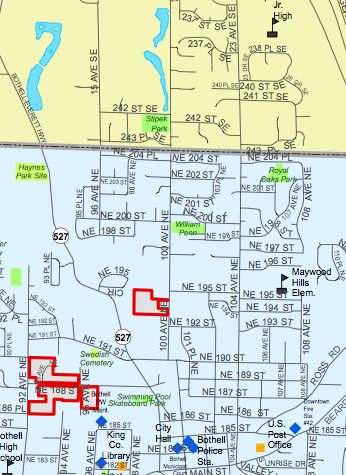Geo-oddities exist everywhere. You just have to look for them. I came across an interesting situation in Bothell, Washington, fascinating in its own right but leading to a confluence of events even more unusual.

So the situation begins with the city’s placement directly atop a boundary line separating King County from Snohomish County. That’s hardly unique. County lines bisect towns all over the place.
Most streets here are named rather unimaginatively, too. Numbered avenues run north-south and numbered streets run east west. As an example, City Hall sits at the northwest corner of 101st Ave., NE and NE 183rd St. So everything here appears boring but conventional. However, let’s consider the situation a little more closely. Examine Bothell’s street names at the county line and something strange takes place.
An Interesting Jump
Notice the addresses. Now click the image forward a single frame. The street name change abruptly, jumping from 100th Ave NE to 19th Ave SE. It happens right where one section has been repaved more recently than the other, forming a mark across the road. That’s the county line. The two counties, King and Snohomish, use vastly different baselines that do not mesh with each other. Bothell, a single town, has completely schizophrenic streets. They change numbers drastically passing from one county to the other, often in mid-block.
Open the image in another tab and switch to map option to see the disjointed naming changes that take place along the county line. Imagine trying to navigate through that mess.
I wanted to see the true extent of the situation but the major online mapping services do not generally provide town boundaries. Instead I went onto the City of Bothell website and found their municipal map. This was a great resource that helped me track the name changes occurring along the line.
Holes Too!
Then I noticed something even more unusual. Bothell hosts four small independent enclaves enclosed entirely within the town’s boundaries.

This is a detail of the Bothell map showing the four enclaves. Notice the yellow and blue parts of the map too. Those are the portions of Bothell on different sides of the county line, where street names change.
So I wondered how those four small spots could have remained a part of unincorporated King County completely surrounded by a town of thirty thousand people. I also figured I’d never get the real answer.
However, sometimes I get lucky like I did today when the answer fell right in my lap. It turns out that Bothell is in the middle of an effort to annex additional territory including the embedded enclaves. An article appeared in the Bothell Reporter [article no longer available on the internet] just a week ago, providing this smoking gun:
“… Incidentally, how exactly did those small swathes, or islands, of unincorporated King County get set aside as Bothell expanded? Wiselogle said as the city grew in the 1930s and 1940s, officials apparently encountered small pockets of opposition here and there. For whatever reason, Bothell made the decision to leave those opposition areas alone and they remain outside the city today.”
Why don’t these people want to live in Bothell?
Actually, that’s not a fair statement. I should probably ask why residents of this enclave didn’t want to live in Bothell back in the 1930s and 1940s. Either way, they’ll soon be joining their neighbors in a common jurisdiction if the annexation succeeds.

Leave a Reply